The
History of Quarrying - The Park and Croesor
Quarries
The Park and
Croesor Quarries
The Park and Croesor Slate Quarries Co. Ltd,
Park and Croesor Quarries,
Penrhyndeudraeth
N. Wales
|
Telegrams: Kellow, Portmadoc
Telephone: P.O. No. 10 Portmadoc
This article, specially written for the SLATE
TRADE GAZETTE, will no doubt prove of the greatest
interest to slate quarry proprietors. It is scarcely
necessary to say that a personal inspection of the
Park and Croesor Quarries would more clearly
demonstrate the efficiency of electric power in its
application to slate quarrying. Where a visit is not
possible, the following description will serve to
give our readers some idea of what has been
accomplished in the early stages of a new era in
roofing slate production.
The properties of the Park and Croesor Slate
Quarries Company, Limited, are upwards of 2,000
acres in extent, and have a length of 312 miles on
the finest range of slate-bearing strata in the
world.
They lie in a direct line from the mouth of the
London and North Western Railway Tunnel at Blaenau
Festiniog to Portmadoc.
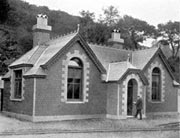 The Company are in membership with the Festiniog
District Slate Quarry Proprietors' Association, and
its quarries form part of the Festiniog group.
The Croesor Narrow Gauge Railway - 8 miles in
length - was constructed, and still serves, to
convey the produce of the Park and Croesor Quarries
to the shipping wharves of Portmadoc, and to the
junction with the Cambrian Railway at the Croesor
siding, Portmadoc, where a large assortment of
slates is always kept in stock ready for dispatch by
rail or water. The Company are in membership with the Festiniog
District Slate Quarry Proprietors' Association, and
its quarries form part of the Festiniog group.
The Croesor Narrow Gauge Railway - 8 miles in
length - was constructed, and still serves, to
convey the produce of the Park and Croesor Quarries
to the shipping wharves of Portmadoc, and to the
junction with the Cambrian Railway at the Croesor
siding, Portmadoc, where a large assortment of
slates is always kept in stock ready for dispatch by
rail or water.
The Festiniog series of veins, comprising in
ascending order The New " or "Deep
Vein,"The Old Vein," "The Small
Vein," "The Back Vein," and "The
North Vein," and lying immediately on a thick
stratum of felspathic porphyry, known locally as
"The GlanypwIl Trap," traverses the
properties for their entire length, and represents a
slate reserve which, at a conservative computation,
amounts to over two thousand millions of tons, of
which over six hundred millions consist of the
world-famous "Old Vein" slate.
It is sad to reflect that the British building
industry should use inferior slate from foreign and
distant countries while a practically inexhaustible
source of supply of the finest slate in the world is
available in their own country, and at their very
doors.
The Moelwyn and Cynicht mountains, which are
well-known landmarks in the country, and are
veritably mountains of slate, are included in the
properties.
The Croesor Quarry was first opened about 55
years ago, and has since been worked on an extensive
scale exclusively for " Old Vein " roofing
slates.
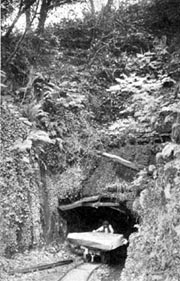 |
The Park Quarry was opened about 10 years later,
and has been chiefly worked for slate for
manufacturing purposes, such as slate ridging,
slabs, etc., the perfect straightness of the
cleavage which characterises the rock of this quarry
rendering it specially suitable for this class of
work.
The two quarries are, in fact, the complement of
one another, enabling the Company to supply its
customers' needs in either roofing slates, slate
ridging, slabs, or any other variety of article
produced in slate.
Both Quarries are worked entirely below ground,
and are, therefore, more correctly describable as
"mines" rather than by their usual
designation of quarries.
At the Croesor mine or quarry, the plan of
development pursued has been that now recognised as
standard in the underground quarries of the
Festiniog neighbourhood, i.e., the alternation of
chambers in which the slate is quarried, with walls
of solid rock left to support the roof. |
The chambers and walls follow, approximately, the
line of dip of the strata (averaging about 27°),
with horizontal galleries, or floors, at convenient
intervals, along which the traffic is conveyed to
the haulage inclines, and thence elevated to the
surface of the ground.
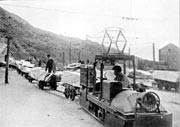 The unusual
thickness of the "Old Vein"
in this Quarry - upwards Of 40yds. at right angles
to the bedding, and over 110 yards on the horizontal
- in conjunction with the fact that it has been
frequently possible to work chambers up to 16 or 17
yards in width without endangering the roof, has
resulted in openings of abnormal size being
produced. The unusual
thickness of the "Old Vein"
in this Quarry - upwards Of 40yds. at right angles
to the bedding, and over 110 yards on the horizontal
- in conjunction with the fact that it has been
frequently possible to work chambers up to 16 or 17
yards in width without endangering the roof, has
resulted in openings of abnormal size being
produced.
To the layman, the existence of these enormous
caverns in the very heart of a mountain is strange
and startling, and few people, who have not
personally visited the quarries, realise even to a
faint degree the conditions under which slate is
obtained.
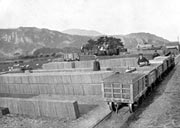 At the Park Quarry owing to a peculiarity in the
dip of the pillaring or grain of the rock, it has
been possible to reverse the ordinary order of
underground quarrying, commencing at the bottom
instead of the top; working the galleries in
ascending order, and leaving the rubbish behind to
support the roof and walls, instead of conveying it
to the surface at great expense, there to become an
unsightly blemish on the landscape. At the Park Quarry owing to a peculiarity in the
dip of the pillaring or grain of the rock, it has
been possible to reverse the ordinary order of
underground quarrying, commencing at the bottom
instead of the top; working the galleries in
ascending order, and leaving the rubbish behind to
support the roof and walls, instead of conveying it
to the surface at great expense, there to become an
unsightly blemish on the landscape.
The various parts of the properties range froul
2560 feet in elevation to practically sea level,
and, being situated near the Atlantic coast, have a
heavy rainfall; this, with unique storing
facilities, provides all the conditions for the
production of hydraulic power to almost any required
extent.
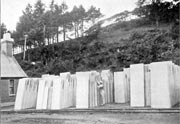 One
artificial reservoir, of about 12 acres in
extent, has been constructed at an elevation of 1460
feet, and another, of about 5 acres, at an elevation
of about 1650 feet, in addition to which there are
natural lakes, of about 6 acres, which are likewise
utilised, at an elevation of about 1750 feet. One
artificial reservoir, of about 12 acres in
extent, has been constructed at an elevation of 1460
feet, and another, of about 5 acres, at an elevation
of about 1650 feet, in addition to which there are
natural lakes, of about 6 acres, which are likewise
utilised, at an elevation of about 1750 feet.
The waters from these (besides from various other
sources) are applied to the driving Of 4 high
pressure turbines (aggregating about 500 H.P.) to an
80 H.P. engine, and to the working of two Overshot
Water Wheels (one Of 40 feet and the other of 20
feet in diameter) and these, in turn, are utilised
for hauling, driving slate mills, pumping, and the
production of electric power on the three-phase
system.
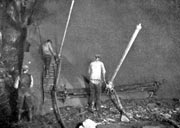 The electric power is applied to all the various
requirements of slate quarrying and manufacturing
where direct driving is not feasible. The electric power is applied to all the various
requirements of slate quarrying and manufacturing
where direct driving is not feasible.
The electric plant comprises machines aggregating
about 775 H.P.
In addition to the use of electric current for
power purposes, it is also utilised for lighting the
quarries underground, and for lighting the mills;
the latter being so efficient that it would be
possible to carry on the manufacture of slate
continuously throughout the 24 hours if so desired.
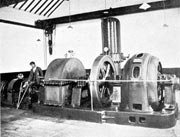
The Hydro-Electric system in use at these
quarries contained when first erected many features
of novelty among these being:
(1) That the head of water utilised was the
highest of any in the British Isles.
(2) That the turbines were of a special, and
exceedingly efficient type.
(3) That it was the first application of the
three-phase electric system to slate mining.
(4) That it involved the use for the first time in
Great Britain of an electric mining locomotive.
(5) That it afforded the first example of the
application of the multi-stage, electrically-driven,
centrifugal pumps to slate-mine drainage.
The Hydro-Electric system here installed was the
subject of a paper read by Mr. M. Kellow (the
General Manager and Engineer of the Company) before
the Institution of Civil Engineers, and it will be
within the recollection of our readers that extracts
from this paper appeared some time ago in the SLATE
TRADE GAZETTE.
Compressed air has been in use for upwards of 30
years for the transmission of power, and, to a small
extent, the working of rockdrills.
For the transmission of power it has, however,
been almost entirely placed, and for rockdrilling
entirely so, by the very much more effective and
convenient electric and hydraulic systems.
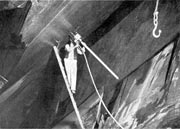 The utilisation of compressed air as a means of
transmitting power, though still in extensive use
throughout the world, is exceedingly inefficient,
the power obtained from the executive engines being
rarely in excess of 10 per cent. of that applied to
the driving of the compressor, no less than 90 per
cent. being wasted in mechanical, compression, heat,
and transmission losses, which are inherent in the
system. The utilisation of compressed air as a means of
transmitting power, though still in extensive use
throughout the world, is exceedingly inefficient,
the power obtained from the executive engines being
rarely in excess of 10 per cent. of that applied to
the driving of the compressor, no less than 90 per
cent. being wasted in mechanical, compression, heat,
and transmission losses, which are inherent in the
system.
When applied to rock-drilling, the result is even
less satisfactory, being of the order of 1 per cent.
of the input to the compressor.
In comparison with these figures, it may be
stated that, with electric transmission at this
Company's quarries as much as 78 per cent. is being
delivered by the motors of the HP. applied to
driving the electric generators at the power station
(one mile distant), and in the case of hydraulic
transmission, approximately 50 per cent. of the
power is usefully applied to rockdrilling and
channelling, in comparison with about 1 per cent. in
the pneumatic system.
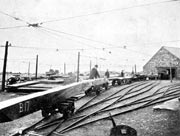 Until recently, and as a result of the
inefficiency and many limitations of
pneumatically-operated drills, the boring of rock
for blasting purposes was done almost entirely by
manual labour in slate quarries throughout the
world; but Mr. M. Kellow, who has been associated
with the slate industry all his lifetime, and who
has made a deep study of the various mining and
mechanical problems connected with it, has invented,
and patented, a Rock Drill, which can be operated by
hydraulic power, with a view to overcoming the
objections and limitations in the pneumatic system. Until recently, and as a result of the
inefficiency and many limitations of
pneumatically-operated drills, the boring of rock
for blasting purposes was done almost entirely by
manual labour in slate quarries throughout the
world; but Mr. M. Kellow, who has been associated
with the slate industry all his lifetime, and who
has made a deep study of the various mining and
mechanical problems connected with it, has invented,
and patented, a Rock Drill, which can be operated by
hydraulic power, with a view to overcoming the
objections and limitations in the pneumatic system.
A limited company, viz., The Kellow Rock Drill
Syndicate, Limited, has been formed to manufacture
and exploit these drills, and already they have
found their way into various important quarries of
the locality.
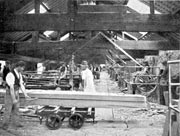 The Syndicate has the support and approval of
many well-known and influential gentlemen connected
with the slate industry. The Syndicate has the support and approval of
many well-known and influential gentlemen connected
with the slate industry.
The drills have been in use for some time past
throughout the Park and Croesor Quarries with very
marked effects upon the output and in lowering the
cost of production.
To realise the tremendous advantage obtainable by
mechanical drilling under this system it may be
stated that holes which formerly took about 6 or 7
hours to bore by hand are now being bored from start
to finish in about 1½ minutes, the average rate of
penetration being about 5 feet per minute, which is
a colitintinus rate, no stoppages for change of
drill being necessary.
One of the most unsatisfactory features in
connection with the slate industry is the deplorable
waste of valuable material which necessarily results
from quarrying methods dependent principally upon
the use of explosives for the removal of rock from
its native bed, and it has been long recognised that
if mechanical methods could be successfully applied
to the extraction of the slate, that the present
percentages of waste, which at present range from
about go per cent. to as high as 97 per cent. even
in well conducted quarries, might be very
substantially reduced; but the great inefficiency
both as regards power and speed of operation by any
previously existing system rendered such processes
commercially impossible, except in a few isolated
cases were the exceptional purity of the rock
justified extraordinary and expensive means for its
removal.
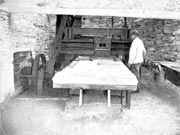 The extension of the Kellow rockdrilling system
to channelling, has already given so much promise of
success, that it may confidently be expected that in
the near future a complete revolution in quarrying
methods will result, the use of explosives being
practically eliminated in favour of the cutting out
of the slate in shapely blocks, with a minimum of
waste. Needless to say, the use of
hydraulically-operated machines which produce no
dust, and the practical elimination of powder smoke
from the workings will also enormously improve the
hygienic conditions for the workmen. The extension of the Kellow rockdrilling system
to channelling, has already given so much promise of
success, that it may confidently be expected that in
the near future a complete revolution in quarrying
methods will result, the use of explosives being
practically eliminated in favour of the cutting out
of the slate in shapely blocks, with a minimum of
waste. Needless to say, the use of
hydraulically-operated machines which produce no
dust, and the practical elimination of powder smoke
from the workings will also enormously improve the
hygienic conditions for the workmen.
The attainment of maximum efficiency which is the
principle that has governed the design of the power
system in use at the quarries and in rock drilling
machinery, extends also to the mills. Here are to be
found machines capable of a larger output than are
to be found elsewhere in the world. For example,
blocks of 8 inch to 12 inch thick are being sawn at
the rate of 3 feet and upwards per minute, without
injuriously affecting the material by heat and
detracting from its good splitting qualities.
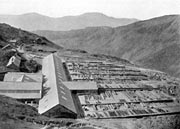 By means of an improved type of planing machine,
a single operator can plane upwards of 10 tons per
day of slabs from the rough, the speed of the table
during the cutting stroke being from 40 feet to 70
feet per minute, and the speed of return from 200
feet to 350 feet per minute. Even at the high speeds of operation indicated,
cuts 2 feet wide by ½ inch deep are being taken.
This represents a rate of work from six to 2 ten
times the normal. By means of an improved type of planing machine,
a single operator can plane upwards of 10 tons per
day of slabs from the rough, the speed of the table
during the cutting stroke being from 40 feet to 70
feet per minute, and the speed of return from 200
feet to 350 feet per minute. Even at the high speeds of operation indicated,
cuts 2 feet wide by ½ inch deep are being taken.
This represents a rate of work from six to 2 ten
times the normal.
The principle which has governed the physical
development and mechanical equipment of the
quarries, has also been applied to the organisation
of the methods of work.
To those acquainted with slate quarrying methods,
the difficulty of organising the work so as to keep
both rockmen and slatemakers continuously employed
is well known. This has arisen chiefly from the
system usually in vogue whereby particular men in
the manufacturing department derived their blocks
exclusively from particular chambers, or bargains,
in the quarry, with the result that the uniformity
of supply could not be relied upon and time was
wasted in consequence.
At these quarries, however, the complete
separation of the rockmen's contracts from those of
the slatemakers was adopted upwards of 15 years ago,
with the result that the entire output of the quarry
in raw material is practically pooled for the
purpose of manufacture, thereby securing a more
uniform and continuous supply of blocks to the
slate-makers and eliminating the losses prevalent
under the alternative system.
There is little doubt that if the slate industry
of Wales is to hold its own against the competition
of foreign slate, the softness of which, while being
detrimental to its lasting qualities, has
contributed to the cheapness of its production, and
the fact that it has been made by workmen earning in
some cases 50 per cent. less wages and working 30
per cent. longer hours than prevails in Welsh
quarries, it must be by means of scientific methods,
and the use of every appliance that will conduce to
efficiency and economy of working.
The foregoing description of the Park and Croesor
Quarries is a proof that at least one Slate Quarry
Company has not only realised the truth of this, but
has followed it by definite action.
Critics of our slate industry have reproached
proprietors with lack of enterprise and a
disposition to cling to antiquated methods of
production. They have asserted that this spirit of
conservatism has been largely responsible for the
inroads made on our home markets by the foreigner
inasmuch as it has retarded the rate of output.
Though there may be a substratum of truth in this
charge, generally speaking, this article proves that
it cannot be universally applied. The Park and
Croesor Quarries, to go no further, employ the most
up-to-date methods and they do not stand alone in
this respect. Foreign competition brings in in its
train a great many evils but it has the advantage,
at any rate, of acting as a spur on the home
producer and forcing him to keep abreast of the
times, if not a little ahead of them.
Reprint from "The Slate Trade Gazette",
February 1911.
Ref: ZM486/3
|